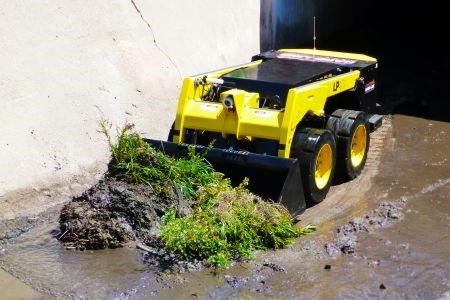The profile of a new HARD-LINE Solutions vehicle might be small, but its impact has been mighty in the state of California.
Measuring a mere 40 inches high, the LP401 has been making a splash in Ventura County where two of the vehicles have been purchased by the county’s public works agency for use in clearing spillways, passages typically built in areas prone to flooding through which surplus water passes when the reservoirs are full.
A remote control-operated skid steer vehicle designed for use in areas that are inhospitable to humans, the 5,000-pound vehicle’s bucket can hold 1,300 pounds and be customized to a client’s needs, said Max Gray, HARD-LINE’s director of marketing and advertising.
“In this particular case, Ventura County needed them to clean spillways, because after heavy rains and storms, mud and leaves and sand get all hung up under the bridges that go over these things,” he said. “It’s really not conducive to sending men in there, so they really just need a big loader to go in there and scrape it all out.”
The municipality contacted HARD-LINE, which is based in the community of Dowling, just north of Sudbury, after compiling a list of equipment requirements and conducting an online search for companies with machinery that met their needs, Gray said. The county’s primary goal, he said, was to reduce hazards to its workers, who would previously have been tasked with the job of going into the spillways to clean them out.
HARD-LINE rented two prototypes to Ventura County a year and a half ago for the public works department to test drive, and the community was so pleased with the results, it purchased two new ones. A third is currently being built and will be used as a demonstration model for potential clients to test out its capabilities.
Since word got out about the vehicles in Ventura County, HARD-LINE has preliminary meetings planned with a few other municipalities in California interested in the LP401. Not all will be able to afford to purchase the vehicles, but Gray said the company is considering other options, such as renting or leasing opportunities. In that scenario HARD-LINE would sell the vehicles to leasing companies and the municipalities could lease or rent them through those companies.
Originally developed for the mining sector, HARD-LINE’s primary target industry, the LP401 is useful in travelling underneath conveyor belts to clean them out, and Gray said the company will be conducting a Canadian marketing campaign for the vehicles around that use.
But the crossover from mining to municipal cleanup demonstrates that HARD-LINE’s robotic technology has applications beyond mining.
“Most of the things we do are in the mining industry, but now we’re seeing that the technology we’ve developed for robotics in the mining industry is applicable to other industries and we’re actively pursuing that,” Gray said. “It doesn’t matter what industry you work in, there are crossovers to other industries that sometimes you don’t find out about until you’re pretty much done the project.”
Yet as the mining industry booms at a blistering pace, automation will be even more in demand, Gray said, and HARD-LINE can now “remote-control virtually anything,” whether it’s a bulldozer or a drill.
Tests show that productivity can actually increase with the use of remote-controlled equipment, since the vehicles can be driven faster, and an operator on the surface can operate more than one machine at a time through tele-remote capabilities, Gray added.
And the advantages to the health and safety of workers are indisputable.
“The technology is getting to the point where you don’t need the human danger aspect to be involved anymore,” Gray said. “You don’t need to be in there if it’s dangerous. You can drive the vehicle in with a tele-remote or radio-remote and not be there. It’s a lot better to bury a machine underground than it is to bury men underground.”




